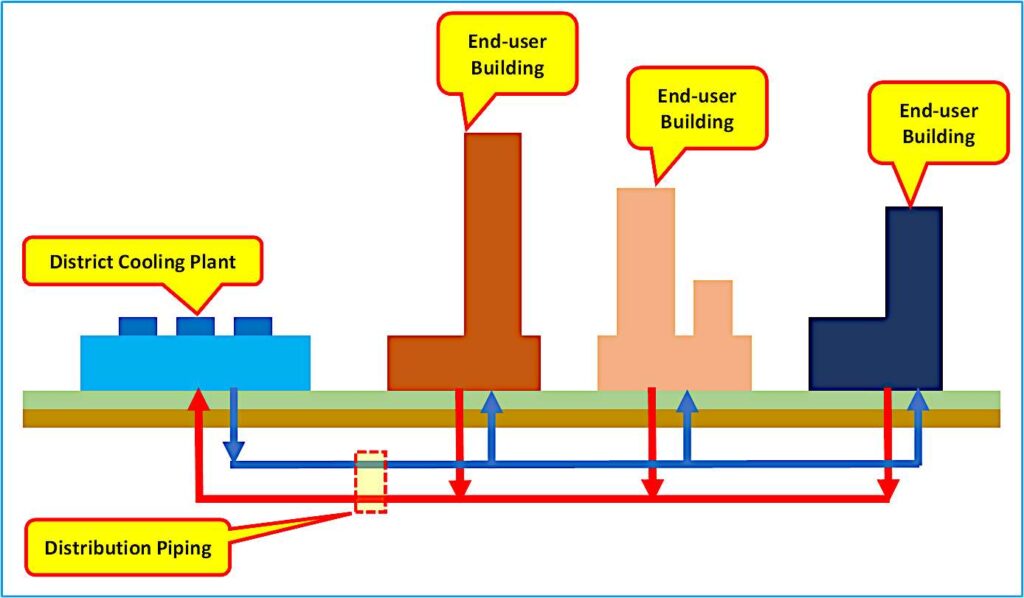Contents
Introduction
District cooling is a sustainable, energy-efficient solution for generating and supplying cooling energy to multiple end-user buildings in a local district. In this article, we will discuss what district cooling is, how it works, and its benefits, along with examples of iconic projects worldwide that have successfully adopted district cooling.
What is district cooling?
District cooling systems produce cooling energy in the form of chilled water at a central chiller plant. The chilled water is supplied to multiple end-user buildings via a piping network for comfort cooling. In traditional in-building air-conditioning systems, each building is provided with its own refrigeration system for producing chilled water. Apart from a few larger-scale developments, most buildings that are smaller in size tend to adopt more energy-intensive cooling technologies such as air-cooled packaged units or water-cooled chiller units without a thermal energy storage system. Compared to traditional in-building cooling plants, the district cooling system offers a sustainable and energy-efficient solution for urban comfort cooling.
District cooling is not new and is considered a mature technology with a well-proven track record. According to ASHRAE, the concept of district cooling can be traced back to the 1880s, and the first commercial district cooling systems were built in the 1930s. While technology has been around for a long time, it has seen a resurgence of interest in the past few decades, particularly in the Middle East, Europe, and South East Asia.
How does district cooling work?
District cooling systems are typically designed as an infrastructure utility service, but they can also be end-user-owned. The centralized production of chilled water for multiple consumer buildings in the same locality provides district cooling systems with economies of scale. This enables district cooling plants to adopt technology options such as thermal energy storage, large capacity, high-efficiency chillers, and series-connected chiller modules, which reduce overall system energy consumption.

Benefits of District Cooling
District cooling offers many advantages over traditional in-building air-conditioning systems, including:
- Energy efficiency: district cooling plants can implement more advanced technology such as thermal energy storage, large capacity, high-efficiency chillers, and series-connected chiller modules, which reduce overall system energy consumption.
- High service reliability: district cooling is often structured as a utility energy service and offers high service reliability, 24×365 service availability, and supply availability on demand.
- Performance Guarantees: District cooling offers guaranteed chilled water supply temperatures and guaranteed cooling capacity.
Examples of Iconic Projects Worldwide
District cooling is being increasingly adopted by forward-thinking urban planners worldwide. Some examples of iconic projects that have successfully adopted district cooling include the following:
- Burj Khalifa in Dubai
- Marina Bay Development in Singapore
- Suvarnabhumi International Airport in Thailand
- Kai Tak Development in Hong Kong
- Raffles City Chongqing, China
- Petronas Twin Towers and Kuala Lumpur City Centre, Malaysia
- Kuala Lumpur International Airport in Malaysia
- Kuala Lumpur International Airport 2 in Malaysia
The success of these landmark projects is testimony that the technology is a viable low-carbon intensity solution for the comfort cooling of modern cities.
Conclusion:
District cooling is a viable energy-efficient solution for decarbonizing the comfort cooling of the urban environment. It is a mature technology with a well-proven track record that offers many advantages over traditional in-building air-conditioning systems. By adopting district cooling, building owners can outsource the production of chilled water to a dedicated team of professionals, mitigating the uncertainties and risks inherent in building, owning, operating, and maintaining an in-building chiller plant.
